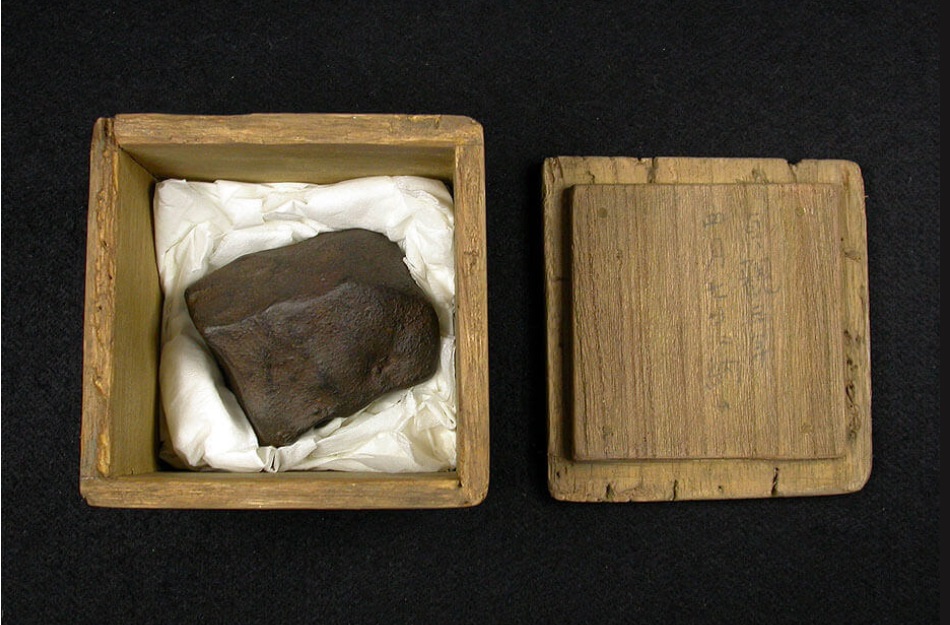
On April 7, in the third year of Jogan, a fireball lit up the sky over Nōgata, in Fukuoka prefecture, Japan. A great explosion was heard, and in the morning villagers awoke to find a deep hole in the gardens of the Suga Jinja shrine. A blackened stone the size of an apple was brought up from the bottom of the hole and given to the Shinto priests to honor this fall from space. Today the stone is kept in the shrine in a wooden box marked with the date (April 7 in the third year of Jogan is May 19, 861 C.E. in the Julian calendar). Once every five years the priests place it in a decorated cart to lead the parade of the Grand Festival of the shrine. Meteorite falls have been observed throughout history, but Nōgata is the earliest known fall where a meteorite fragment survives.
At about 9pm on December 10, 1992, during a fierce thunderstorm over the skies of Mihonoseki, Shimane Prefecture, Masaru Matsumoto's evening was interrupted by a loud crash. At first he thought that lightning had struck his house, but in the morning he discovered that a 14-pound meteorite had smashed through his roof, broken through the second- and first-floor ceilings, and made a hole in the ground floor.
Two meteorite falls, separated by 1,132 years and 185 miles. But amazingly, the two meteorites come from the same place in the heavens! Chemical analysis by Masako Shima, Akihiko Okada, and Keisuke Nagao of the National Science Museum at Okayama University suggests that the Mihonoseki meteorite and the Nōgata stone are from the same parent body, shrapnel from a violent collision of asteroids some 60 million years ago.
Meteorites have helped shape the development of our planet, and meteorites have been a source of wonder for people since prehistoric times. On this website you can find out what types of meteorites there are, their origins, and the craters they make. You can also catch up on the latest meteorite news. If you have information about meteorites you would like to share, please let us know!

There are six main types of meteorites – chondrites, carbonaceous chondrites, achondrites, irons, pallasites, and mesosiderites. The first three are all stony meteorites, while pallasites and mesosiderites are often grouped together as "stony-irons". Despite some basic similarities, the six types are distinctive enough that they each deserve their own category.
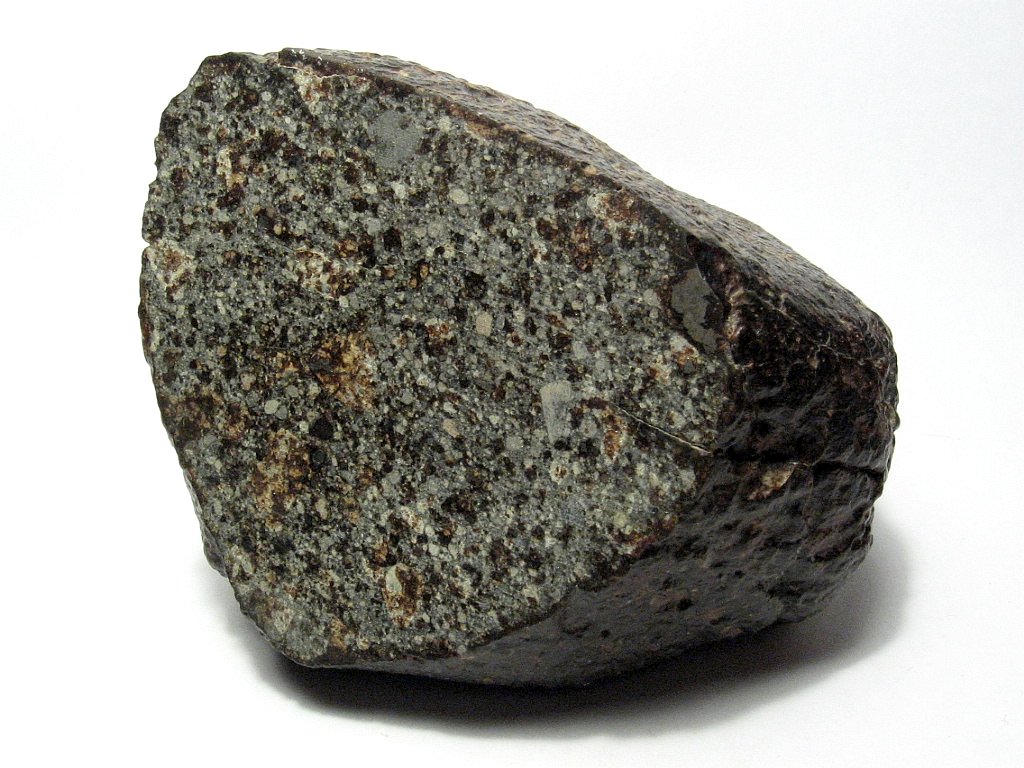
Chondrites are the among oldest and most primitive matter found on Earth. They formed fairly close to the Sun in the earliest period of the Solar System and, except for some alteration due to heat, they have remained largely unchanged since they were formed. In the average chondrite, sixty to eighty percent of the volume is made up of chondrules, and the rest is essentially primordial space dust fused together by heat. The chondrules themselves were originally primordial space dust, too, but pulses of heat in the extremely early Solar System caused small clumps of dust to melt and form small grains of rock (the word "chondrule" is from the Ancient Greek word for "grain"). Chondrules are usually less than one millimeter in size, and the variety of colors they come in make some meteorites very beautiful. Chondrites as a group are further distinguished by their iron content. "H" chondrites are high in iron, about 25 to 31 percent by weight, with about half of that being metallic iron. "L" chondrites are lower in iron, 20 to 25% by weight, with four to 10 percent of their weight being metallic iron. Both H and L chondrites will be attracted to ordinary magnets. "LL" chondrites are "Low iron, Low metal". They are 19-22 percent iron by weight, but less than three percent of their weight is metallic iron. All three types are further classified with a number from 3 to 7. This represents how much the chondrules have been altered by heat, with 3 being least altered and 7 being almost entirely melted. About 80% of the meteorites that fall to Earth are chondrites, with H and L chondrites being the most common.
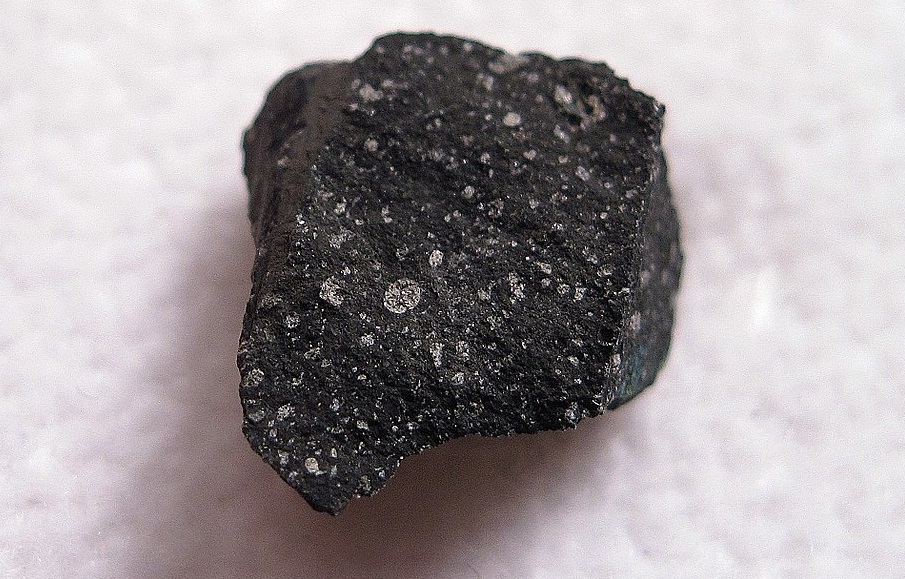
Carbonaceous chondrites are as old or older than ordinary chondrites, and they are even more unchanged from their primitive state. Like chondrites, they formed out of chondrules and dust in the early Solar System, but they formed farther away from the Sun where it was cool enough for water to exist, and where there was more carbon. Carbonaceous chondrites can be as much as 22 percent water and as much as five percent carbon. Depending on the type, between zero and seventy percent of their volume is chondrules, with most types being just under half. Carbonaceous chondrites often also have calcium–aluminum-rich inclusions (CAIs), which are even older than chondrules. The oldest known CAIs have been dated at slightly more than 4.568 billion years old. One particularly fascinating thing about carbonaceous chondrites is that they contain complex organic compounds. The meteorite Murchison has over 70 types of extraterrestrial amino acids! Scientists hope that by studying carbonaceous chondrites they will learn more about the origins of life on Earth. A bit less than five percent of the meteorites that fall to Earth are carbonaceous chondrites.
Iron meteorites, pallasites, mesosiderites, and most achondrites have one important thing in common. They all come from parent planets or planetoids that were large enough to have differentiated into having an iron core surrounded by a stony mantle and crust. Iron meteorites come from the cores of these parent bodies. Achondrites (except for "primitive" achondrites) came from the rocky outer parts, and pallasites come from the transitional areas that were part metal and part stone. Mesosiderites are probably pieces of iron core that have been broken apart and mixed together with rocky crust material. Unlike all of these, "primitive" achondrites are really much more like ordinary chondrites. Their parent bodies never differentiated, but at some point in their history they were subjected to enough heat that all of their chondrules melted and blended together with the rest of their material.
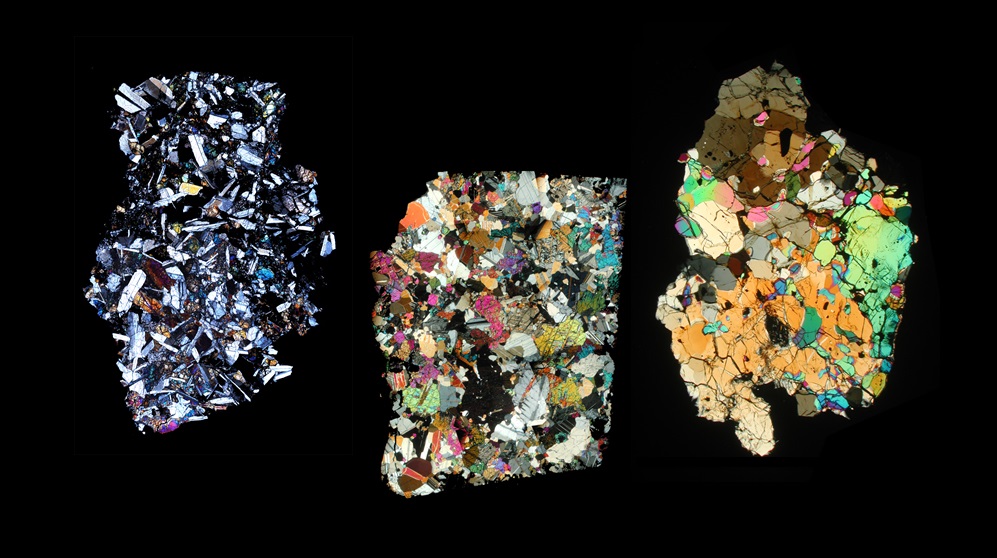
Some achondrites originally came from the Moon, and some originally came from Mars. There are many ways for scientists to determine that a meteorite has a lunar or Martian origin. The overall chemical composition is a clue. The Moon and Mars have different ratios of noble gas and oxygen isotopes than the Earth does, and this can be measured in the meteorites. Rocks also preserve a record of what magnetic field they were exposed to when formed, and the magnetosphere of Earth is very strong relative to what is found on the Moon and Mars. In the case of lunar meteorites, they can be compared to samples of lunar rocks brought back to Earth by the Apollo and Luna space missions. Mars meteorites can be compared to data sent back from the various Mars probes and rovers.
The HED achondrites come from the asteroid 4 Vesta. The spacecraft "Dawn" spent 14 months in orbit around Vesta, and the detailed images and spectrographic data it was able to obtain leave few doubts about HED origins. "HED" stands for "Howardite, Eucrite, and Diogenite". Eucrites are from the outer crust of Vesta; diogenite is plutonic rock that came from deeper in Vesta's crust; and howardite is a broken-up and reformed mixture of the two. There are two other kinds of non-primitive achondrites, aubrites and angrites, both of which are quite rare. More than 50,000 meteorites have been found on Earth, and fewer than 100 of them are aubrites or angrites. Counting the primitive achondrites, about eight percent of the meteorites that fall are achondrites, with two-thirds of them being HED achondrites.
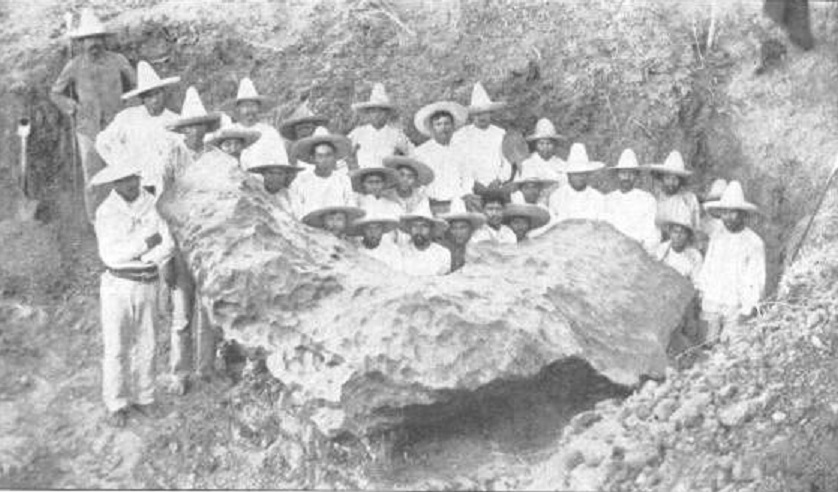
Iron meteorites make up a bit less than six percent of the meteorites that fall to Earth, but they are much more likely than stone meteorites to survive the fall intact. They are also much easier to find than stony meteorites (most of which just look like regular rocks). And they are denser than stony meteorites. As of 2004, iron meteorites made up about ninety percent of the mass of all the meteorites that had been found by humans, but the pace of meteorite-finding has risen sharply since then. Iron meteorites as sometimes called "iron-nickel" meteorites, because between five and twenty-five percent of their mass is nickel. Iron from meteorites was used by humans before they learned to smelt their own iron. The ancient Egyptians made iron beads out of meteoric iron more than 5,000 years ago, and the Pharaoh Tutankhamun was buried with a dagger, a bracelet, and a headrest that all had meteoric iron parts. Another dagger made of meteoric iron was found in a 4500-year-old grave in Alaca Höyük, Turkey. Meteoric iron artifacts have also been found from ancient Syria and from Shang Dynasty sites in China.
One thing that shows whether iron is of meteoric origin is the presence of a Widmanstatten pattern when slices of the iron are etched with acid. These distinctive angular patterns are the result of the iron having cooled from a molten temperature at a very slow rate, such as would have happened in the cores of ancient protoplanets. In the process of cooling and solidifying, alternating bands of nickel-rich taenite and nickel-poor kamacite form. Taenite is more resistant to acid than kamacite, and shows up as light bands after etching.
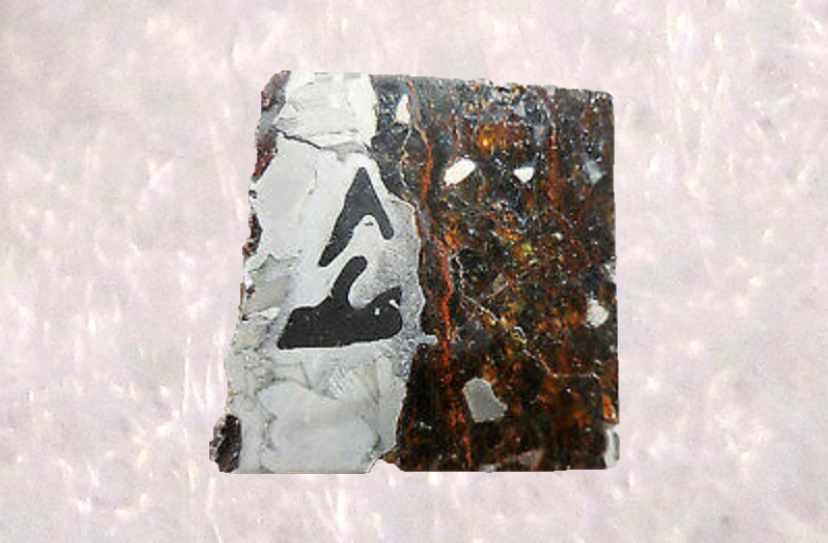
Pallasites are rare, only about one percent of falls, but they reveal the most beautiful structures when sliced. Each pallasite is different, but they typically have golden olivine crystals in an iron matrix. Sliced thin enough, the crystals are translucent, and whole olivine crystals are often made into beads for use in jewelry. Despite the name, they are not associated with the asteroid 2 Pallas; instead they are named after the German naturalist Peter Pallas, who in 1772 studied the first pallasite (Krasnojarsk) recognized as a meteorite. Portions of pallasite meteorites that have only iron and no crystals are called siderites.
Like pallasites, mesosiderites are a mixture of metal and stone, but unlike pallasites the metal bits are relatively evenly distributed and the stony bits are not crystals. They are typically about half iron. Only about 260 mesosiderites have been found. The most famous is the Vaca Muerta ("Dead Cow") meteorite from Chile, whose pieces have a total weight of about 3.8 tons. It didn't kill any cows when it fell; the name comes from a dry riverbed near where it was discovered. Some mesosiderites may come from the asteroid 16 Psyche, which is thought to be the exposed metal core of an ancient protoplanet.
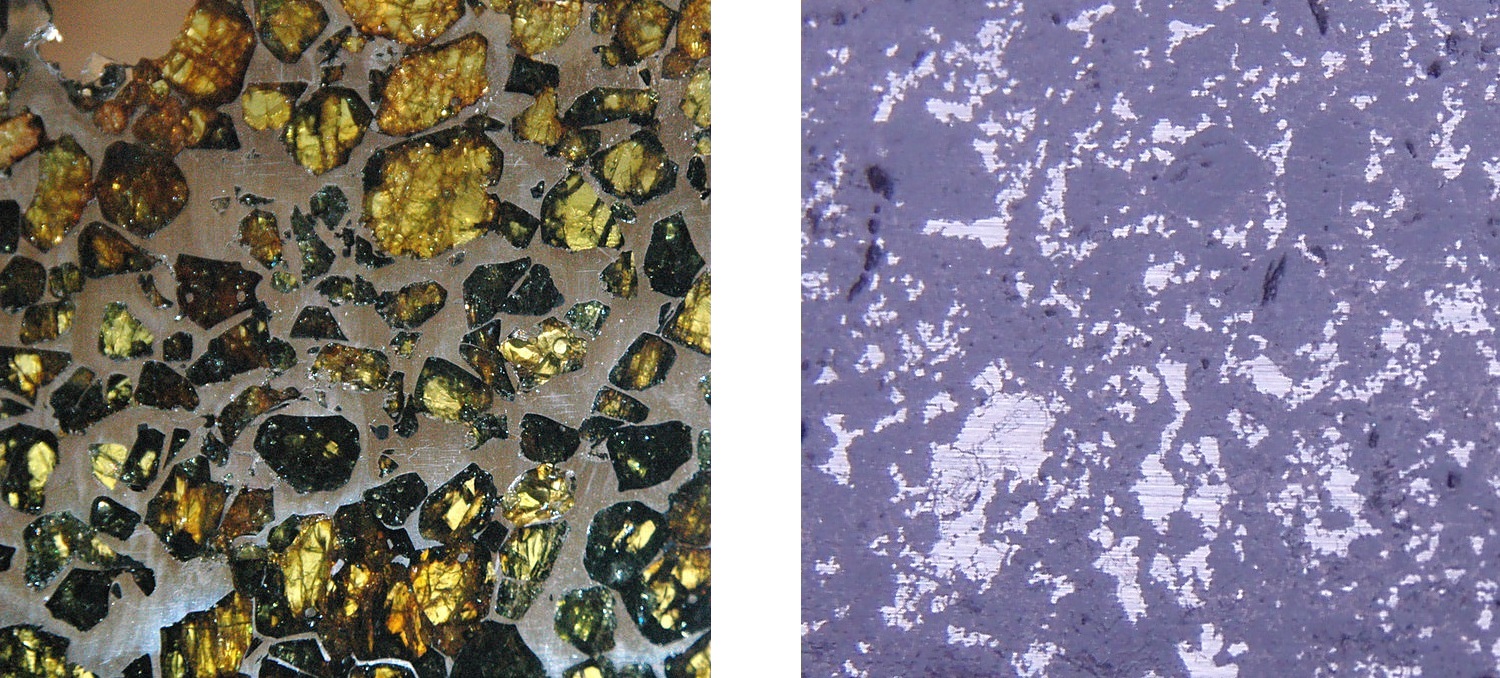
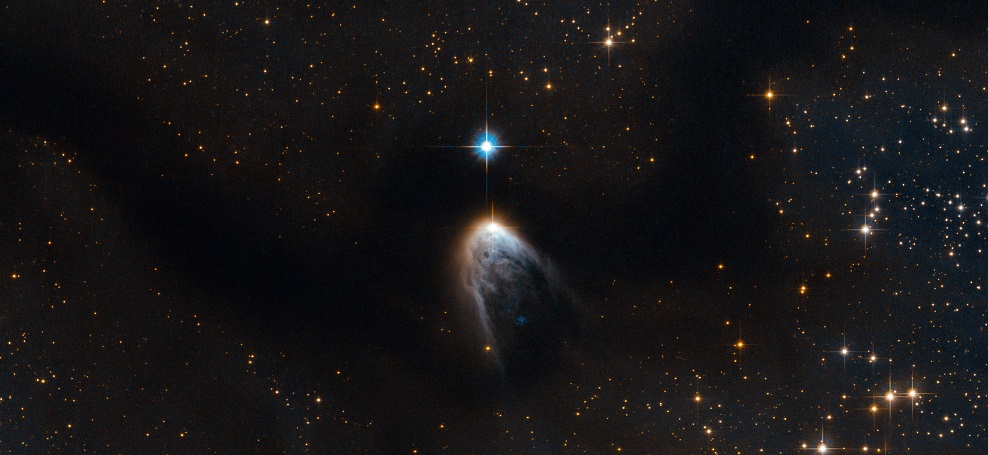
Before there was a Solar System, there was a giant molecular cloud, 65 light-years across and with enough matter to make eight thousand suns. Mostly molecular hydrogen, the cloud also contained tiny clumps of dust – minuscule remnants of long-dead stars. Today we call those clumps "presolar grains", and scientists are able to find them inside some meteorites. The Murchison meteorite from Australia has presolar grains that have been dated to between one and three billion years older than the sun, making them the oldest known material on Earth!
A shock wave – probably from a supernova $ndash; surged through the cloud. Pushed by the wave, and pulled together by gravity, pockets of the cloud began to collapse inward. A thousand, maybe ten thousand, dense cores formed, spinning and shrinking in violent whirlpools of particles. As the matter condensed, millions and billions of particles began to collide with one another, each collision releasing heat. For a thousand centuries, the cores got smaller and smaller, and hotter and hotter, spinning faster and faster. At the cores' centers, protostars formed, and the clouds around them flattened into protoplanetary disks. It would take millions of years more of matter rushing to the cores' centers, but eventually the larger protostars would get dense enough for nuclear fusion. Out of the giant molecular cloud, in a cosmic blink of an eye, a cluster of stars formed and then began to spread apart, each of the thousand to ten thousand going its own way. A nursery-mate of our sun, a star named HD 162826, has recently been found 110 light years away in the constellation Hercules.
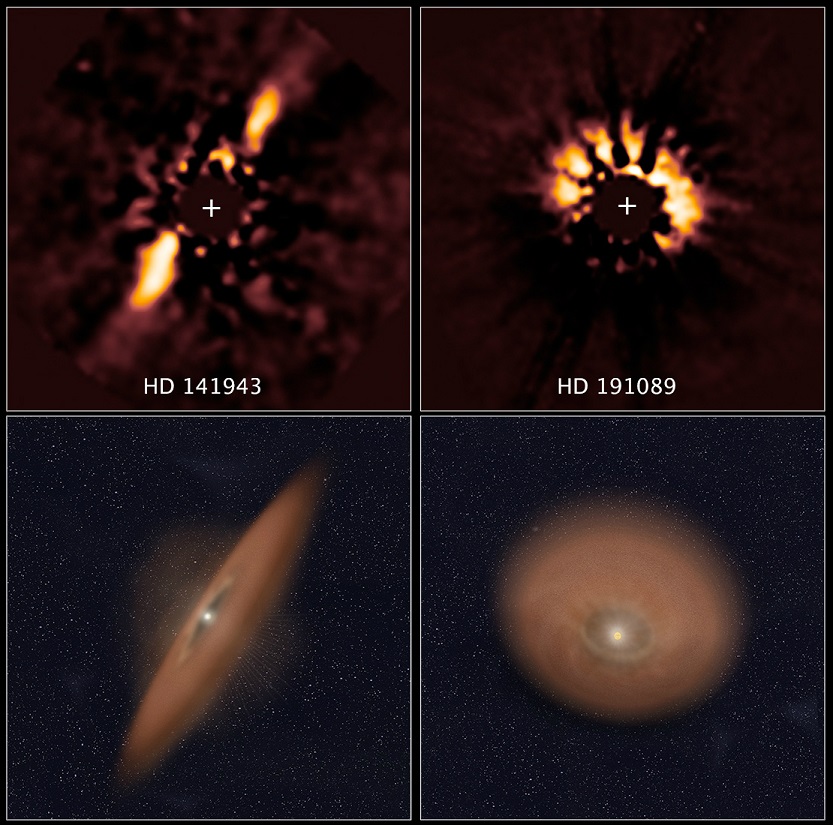
In the protoplanetary disk around our sun, the presolar grains of dust began to form larger clumps. The first solids to condense, when the gas in the disk was still around 1200-1300 Kelvin, were rich in calcium and aluminum, with silicon and oxygen binding them together. Carbonaceous chondrite meteorites have little, whitish specks called calcium–aluminum-rich inclusions, or CAIs, that were formed in this first period of the sun's existence. A CAI from meteorite NWA 2364 has been dated to 4568.22 ± 0.17 million years old.
Chondrules, the small grains found in most stony meteorites, were the next solids to form, as the protoplanetary disk cooled to about 1000 Kelvin (1340° Fahrenheit). Soon after they formed they were melted by giant pulse of energy, probably from another supernova. When they cooled again they had glassy outer surfaces around centers mostly made of olivine and pyroxene.
As they continued to spin around the proto-sun, chondrules and CAIs began accumulate coatings of dust, and to stick together when they met, forming them into larger and larger masses. When they reached the size of about one kilometer across, their gravity became strong enough to give them internal structure. They were also large enough now that their gravity could attract more matter. At this point, these bodies are called "planetesmials". And when enough planetesmials come together to form a bodies between 100 and 1000 kilometers across, they are called "protoplanets". Depending on their composition and how hot they are, larger protoplanets can begin to differentiate, with the heavier iron and nickel in them forming their central core, and their lighter elements forming a rocky mantle and crust. Asteroid 4 Vesta may be the only remaining fully-differentiated protoplanet from the early period of the Solar System's formation that did not go on to form part of a planet or a moon. The protoplanets, planetesmials, and smaller bodies continued to collide and merge into larger and larger bodies. By about 25 million years after the first CAIs had solidified, the Earth had been formed.
Near the sun it was too hot for water to form, so the Sun's gravity gathered up the hydrogen that made up the majority of the protoplanetary disk. Outside the "frost line", out near where the asteroid belt is today, water was able to form and freeze. Near the inner boundary of this area, the larger planets began to form. Because they collected water as well as rocky material, they became large enough to capture hydrogen and become gas giants. Jupiter formed first, and so became the largest. Saturn, Uranus, and Neptune probably also formed in the frost-line boundary area, before gravitational interaction with Jupiter caused them to move outward to where they are today. The parent bodies of carbonaceous chondrites likely formed out beyond the frost line as well, since these meteorites contain water.
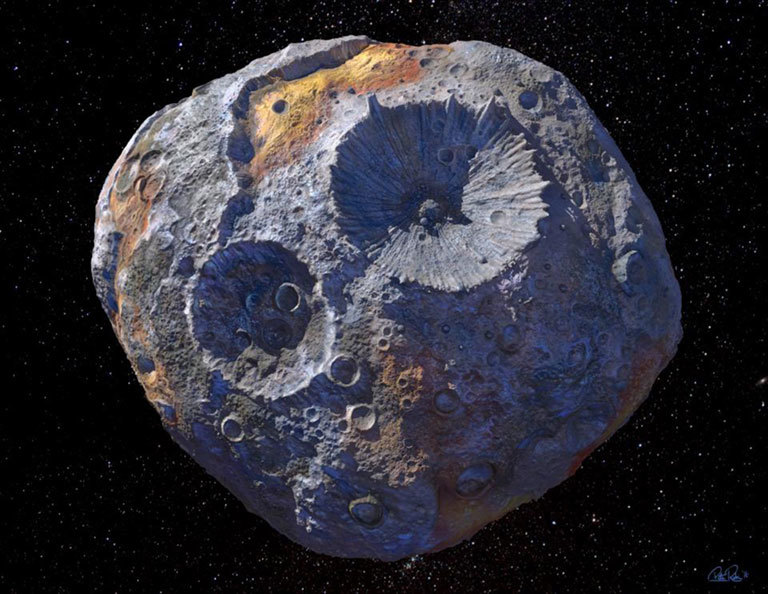
As planetary formation was going on, the sun also finished its growth and passed the early phases of its development. It went from being a protostar through an intermediate form called a "T Tauri star". Within about 50 million years of the original collapse of the molecular cloud, the sun became massive enough for nuclear fusion to begin. With a core temperature passing 14 million Kelvin, the sun was entering the main phase of its life, becoming what is known as a "main-sequence" star. Now, a little more than 4.5 billion years later, the sun is about halfway through its main-sequence lifetime.
The stage was now set. The sun and the planets were formed, along with numerous planetesmials and a few other protoplanets. Collisions between the planetesmials and protoplanets would sometimes cause them to shatter, and the meteorite that are still falling to Earth today are the result. Three pulverized planetesmials are thought to be the source of the three types of ordinary chondrites, H, L, and LL. The iron meteorites are the remnants of shattered cores from up to 50 other parent bodies. HED achondrites were broken off from Vesta. Mesosiderites may be from asteroid 16 Psyche, and some meteorites are bits of the Moon and Mars, heaved into space by collisions occurring there. We're still learning about which parent bodies are the sources of other meteorites, and every year we find more meteorites to help us make discoveries.
Here are some recent (and not-so-recent) news articles featuring meteorites or meteorite-related topics. Check back often as this page will be updated frequently. Links that are new to this page will be shown at the top for 30 days, and then they will be put into the main list in chronological order.
Meteorite Times Magazine
Meteorite Times Magazine is an on-line magazine devoted to every area of meteorite interest. Readers will find it full of meteorite articles, images, and stories about the people of the meteorite community. It is brought to you by The Meteorite Exchange, Inc. Read and learn about meteorites through the eyes of meteorite collectors, hunters, dealers, and researchers, as they study, hunt for, photograph, and collect meteorites from around the world. Issues are published six times a year. Back issues are available.
Meteoritical Bulletin Database
The searchable database of all officially classified meteorites.
The International Meteorite Collectors Association
The International Meteorite Collectors Association (IMCA Inc.) has two primary purposes: helping meteorite collectors in their search for authentic meteorites for their collections, and assisting others in helping to learn more about meteorites. The IMCA has stringent requirements for membership, so buying from a dealer that is a member is usually safe.
The Meteoritical Society
The Meteoritical Society is an international organization dedicated to the promotion of research and education in planetary science with emphasis on the studies of meteorites and other extraterrestrial materials that further our understanding of the origin of the solar system. The Society was established in 1933.
Impactika
A respected dealer in the Tucson area. IMCA member.
Meteor-Center
An online dealer since 2003. Member of IMCA and the Meteoritical Society.
Meteorite Market
A well-respected online dealer since 1995. The website contains a tremendous amount of great information about meteorites.
Mile High Meteorites
A trusted online dealer for more than two decades.
New England Meteoritical Services
New England Meteoritical Services offers meteorite testing, analysis and identification. They have an educational website and offer meteorites for sale.

